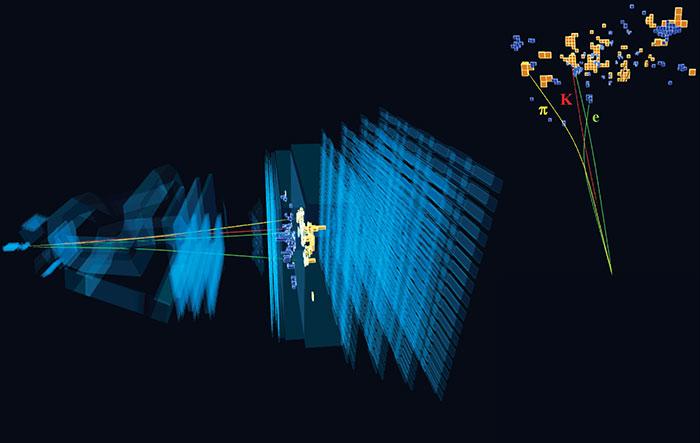
Credit: LHCb Collaboration
Imperial physicists are part of a team that has announced ‘intriguing’ results that potentially cannot be explained by our current laws of nature.
The LHCb Collaboration at CERN has found particles not behaving in the way they should according to the guiding theory of particle physics – the Standard Model.
The Standard Model of particle physics predicts that particles called beauty quarks, which are measured in the LHCb experiment, should decay into either muons or electrons in equal measure. However, the new result suggests that this may not be happening, which could point to the existence of new particles or interactions not explained by the Standard Model.
Physicists from Imperial College London and the Universities of Bristol and Cambridge led the analysis of the data to produce this result, with funding from the Science and Technology Facilities Council. The result was announced today at the Moriond Electroweak Physics conference and published as a preprint.
Beyond the Standard Model
The Standard Model is the current best theory of particle physics, describing all the known fundamental particles that make up our Universe and the forces that they interact with.
However, the Standard Model cannot explain some of the deepest mysteries in modern physics, including what dark matter is made of and the imbalance of matter and antimatter in the Universe.
Researchers have therefore been searching for particles behaving in different ways than would be expected in the Standard Model, to help explain some of these mysteries.
Dr Mitesh Patel, from the Department of Physics at Imperial and one of the leading physicists behind the measurement, said: “We were actually shaking when we first looked at the results, we were that excited. Our hearts did beat a bit faster.
“It’s too early to say if this genuinely is a deviation from the Standard Model but the potential implications are such that these results are the most exciting thing I’ve done in 20 years in the field. It has been a long journey to get here.”
Building blocks of nature
Today’s results were produced by the LHCb experiment, one of four huge particle detectors at CERN’s Large Hadron Collider (LHC).
The LHC is the world’s largest and most powerful particle collider – it accelerates subatomic particles to almost the speed of light, before smashing them into each other. These collisions produce a burst of new particles, which physicists then record and study in order to better understand the basic building blocks of nature.
The updated measurement questions the laws of nature that treat electrons and their heavier cousins, muons, identically, except for small differences due to their different masses.
According to the Standard Model, muons and electrons interact with all forces in the same way, so beauty quarks created at LHCb should decay into muons just as often as they do to electrons.
But these new measurements suggest the decays could be happening at different rates, which could suggest never-before-seen particles tipping the scales away from muons.
Dr Paula Alvarez Cartelle, of the University of Cambridge, was one of the leaders of the team that found the result. She said: “This new result offers tantalising hints of the presence of a new fundamental particle or force that interacts differently with these different types of particles.
“The more data we have, the stronger this result has become. This measurement is the most significant in a series of LHCb results from the past decade that all seem to line up – and could all point towards a common explanation.
“The results have not changed, but their uncertainties have shrunk, increasing our ability to see possible differences with the Standard Model.”
Not a foregone conclusion
In particle physics, the gold standard for discovery is five standard deviations – which means there is a 1 in 3.5 million chance of the result being a fluke. This result is three deviations – meaning there is still a 1 in 1000 chance that the measurement is a statistical coincidence. It is therefore too soon to make any firm conclusions.
Dr Konstantinos Petridis of the University of Bristol’s School of Physics was one of the leading physicists behind the measurement.
He said: “This has been a seven-year saga. Over this period, we have been seeing clues of a new unexplained process at work, but the effects were too subtle to draw any conclusions. The latest result from LHCb however offers for the first-time evidence that there could be something wrong with our current understanding of particle physics.
“We are very excited about this result but remain cautious as well. PhD students in the Bristol particle physics group are leading the studies required to confirm or refute these exciting results.
“The discovery of a new force in nature is the holy grail of particle physics. Our current understanding of the constituents of the Universe falls remarkably short – we do not know what 95 percent of the Universe is made of or why there is such a large imbalance between matter and anti-matter.”
It is now for the LHCb collaboration to further verify their results by collating and analysing more data, to see if the evidence for some new phenomena remains. The LHCb experiment is expected to start collecting new data next year, following an upgrade to the detector.
###
Media Contact
Hayley Dunning
[email protected]
Original Source
https:/




